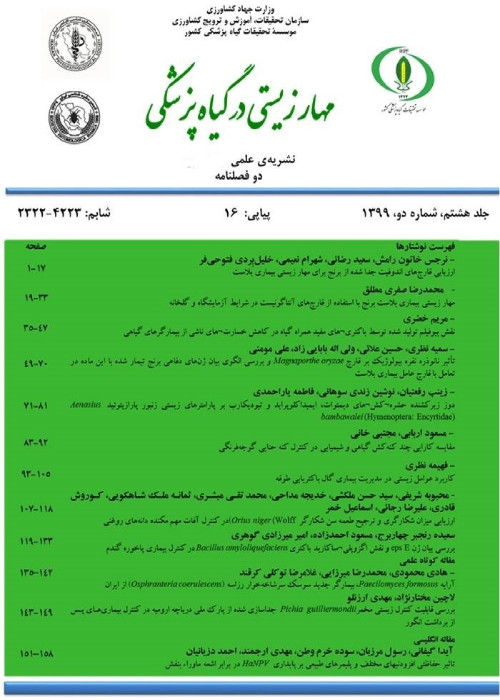Effect of temperature on developmental rate of Hippodamia variegata by feeding on pomegranate green aphid, Aphis punicae
Author(s):
Abstract:
Characteristics such as lower developmental time, higher fertility and a large body size of natural enemies as biological control agents are important for mass rearing. Hippodamia variegate (Goeze) (Col.: Coccinellidae) is one of the major predators of pests in the gardens of Iran. The effect of six constant temperatures, 17.5, 20, 22.5, 25, 27.5 and 30 (±1) ºC were investigated on the development of the predator by feeding on the pomegranate green aphid Aphis punicae (Hem.: Aphididae) in growth chamber with 65±5%RH and 16L: 8D h conditions. The results showed that there were significant differences among developmental times of the studied coccinellid in examined temperatures. The developmental time of H. variegata were 46.01± 1.541, 23.77 ± 0.311, 16.02 ± 0.16, 11.66 ± 0.12, 10.45 ± 0.20 and 13.35 ± 0.33 days on above mentioned temperatures, respectively. Developmental rate of predatory coccinellid increased linearly in relation to temperature to 27.5 ºC. The lowest mortality was observed at 20 and 27.5ºC among the above mentioned temperatures. Two mathematical models, including common and Ikemoto and Takai linear models, were used to describe temperature-dependent development of the H. variegata. Based on the statistical criteria, whereas the common linear model had shown an acceptable fit to data, Ikemoto and Takai linear model estimated thermal indices more precisely than common linear model. Estimated values for lower temperature threshold for incubation period, total larval period, pupal period and overall immature stages of the H. variegata were 11.15, 14.13, 15.52 and 13.99 °C, respectively, and the values of the thermal requirement for the mentioned above developmental stages were 44.69, 79.22, 23.62 and 157.34 degree-days, respectively, by using Ikemoto and Takai linear model. Moreover, mathematical models for description of temperature-dependent development of the coccinellid developmental stages were presented. The results show that optimum temperature was 25 to 27.5ºC for the rearing of the lady beetle.
Keywords:
Language:
Persian
Published:
BioControl in Plant Protection, Volume:3 Issue: 2, 2016
Pages:
19 to 34
magiran.com/p1511835
دانلود و مطالعه متن این مقاله با یکی از روشهای زیر امکان پذیر است:
اشتراک شخصی
با عضویت و پرداخت آنلاین حق اشتراک یکساله به مبلغ 1,390,000ريال میتوانید 70 عنوان مطلب دانلود کنید!
اشتراک سازمانی
به کتابخانه دانشگاه یا محل کار خود پیشنهاد کنید تا اشتراک سازمانی این پایگاه را برای دسترسی نامحدود همه کاربران به متن مطالب تهیه نمایند!
توجه!
- حق عضویت دریافتی صرف حمایت از نشریات عضو و نگهداری، تکمیل و توسعه مگیران میشود.
- پرداخت حق اشتراک و دانلود مقالات اجازه بازنشر آن در سایر رسانههای چاپی و دیجیتال را به کاربر نمیدهد.
In order to view content subscription is required
Personal subscription
Subscribe magiran.com for 70 € euros via PayPal and download 70 articles during a year.
Organization subscription
Please contact us to subscribe your university or library for unlimited access!


